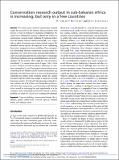Files in this item
Conservation research output in sub-Saharan Africa is increasing, but only in a few countries
Item metadata
| dc.contributor.author | Pototsky, Christy | |
| dc.contributor.author | Cresswell, Will | |
| dc.date.accessioned | 2020-12-17T11:30:08Z | |
| dc.date.available | 2020-12-17T11:30:08Z | |
| dc.date.issued | 2020-12-02 | |
| dc.identifier | 265942443 | |
| dc.identifier | e21f2a6a-8258-4bf8-af18-cb3eed42bd63 | |
| dc.identifier | 85097232831 | |
| dc.identifier | 000721328300029 | |
| dc.identifier.citation | Pototsky , C & Cresswell , W 2020 , ' Conservation research output in sub-Saharan Africa is increasing, but only in a few countries ' , Oryx , vol. 54 , no. FirstView . https://doi.org/10.1017/S0030605320000046 | en |
| dc.identifier.issn | 0030-6053 | |
| dc.identifier.other | ORCID: /0000-0002-4684-7624/work/85563020 | |
| dc.identifier.uri | https://hdl.handle.net/10023/21171 | |
| dc.description.abstract | We tested if peer-reviewed conservation research output has increased in sub-Saharan African countries over the last 30 years in response to increased development. We carried out a bibliometric analysis to identify the number of conservation research papers published by national authors of 41 sub-Saharan African countries during 1987–2017, to provide an index of national conservation research output. We identified country-specific development factors influencing these totals, using general linear modelling. There were positive relationships between conservation research output and population size, GDP, literacy rate, international tourism receipts and population growth rate, and negative relationships with urban population and agricultural land cover, in total explaining 77% of variation. Thirty-eight per cent of countries contributed < 30 conservation research papers (of 12,701) in 30 years. Analysis of trends in primary authorship in a random subsample of 2,374 of these papers showed that primary authorship by sub-Saharan African authors has increased significantly over time but is now at a lower rate than primary authorship for authors from countries outside the country associated with the search term, usually a European or North American country. Overall, 46% of papers had national primary authors, but 67% of these were South African. The results show that conservation research output in sub-Saharan Africa overall is increasing but only significantly in a few countries, and is still dominated by non-national scientists, probably as a result of a lack of socio-economic development. | |
| dc.format.extent | 10 | |
| dc.format.extent | 303721 | |
| dc.language.iso | eng | |
| dc.relation.ispartof | Oryx | en |
| dc.subject | Conservation biology | en |
| dc.subject | Capacity building | en |
| dc.subject | Development | en |
| dc.subject | Research trends | en |
| dc.subject | Papers | en |
| dc.subject | Publications | en |
| dc.subject | Research capacity | en |
| dc.subject | Sub-Saharan African | en |
| dc.subject | QH301 Biology | en |
| dc.subject | ZA4050 Electronic information resources | en |
| dc.subject | 3rd-DAS | en |
| dc.subject | SDG 8 - Decent Work and Economic Growth | en |
| dc.subject.lcc | QH301 | en |
| dc.subject.lcc | ZA4050 | en |
| dc.title | Conservation research output in sub-Saharan Africa is increasing, but only in a few countries | en |
| dc.type | Journal article | en |
| dc.contributor.institution | University of St Andrews. School of Biology | en |
| dc.contributor.institution | University of St Andrews. Centre for Biological Diversity | en |
| dc.contributor.institution | University of St Andrews. Scottish Oceans Institute | en |
| dc.contributor.institution | University of St Andrews. Institute of Behavioural and Neural Sciences | en |
| dc.contributor.institution | University of St Andrews. St Andrews Sustainability Institute | en |
| dc.identifier.doi | 10.1017/S0030605320000046 | |
| dc.description.status | Peer reviewed | en |
This item appears in the following Collection(s)
Items in the St Andrews Research Repository are protected by copyright, with all rights reserved, unless otherwise indicated.

